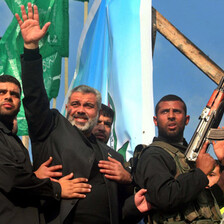The Electronic Intifada 2 March 2001
As the Second Intifada entered its thirteenth day, on Tuesday 10 October 2000, media organisations were focused on Barak’s ‘generous’ extension of the deadline for the Palestinians to “cease their violence’, on the three Israeli soldiers taken hostage by Hezballah in Lebanon, and on the Kofi Annan visit.
For two-and-a-half days, since it began on the night of Saturday 7 October 2000, large groups of settlers were rampaging through Palestinian villages and towns in the West Bank and 1948 areas/inside the Green Line, attacking Palestinians and their property. In many cases they were protected and even aided by the Israeli military.
Tanks, heavy artillery, and helicopters were deployed around all Palestinian cities in Gaza, and tanks were deployed around Gilo settlement near Bethlehem, and the Pisgot settlement on Jebal Al-Tawwl in Ramallah. During the night, literally thousands of Israeli settlers (in many cases together with Israeli soldiers) attacked Palestinian villages and towns in the West Bank and 1948 areas (Nazereth, Bidya, Sourif, Salfit area) and East Jerusalem neighborhoods (Shufat, Al Azeriyeh, Anata, and Sheik Jarrah). Attacks included the use of live ammunition and beatings, and acts of serious vandalism included the burning of shops, cars, and olive groves.
This widespread outbreak of Israeli violence — ironically during a time where the phrase “Palestinian violence” had been a media mantra — was all but completely ignored by the media. One Palestinian journalist noted that this was largely because no footage existed of the Israeli violence, for consumption by the image-oriented television news.
Where a few media reports did touch on these events, they were characterised as “fighting” between Palestinians and Israelis.
The first article noted (i.e. not necessarily the first article) that reported on any settler violence came two days after it began, on Tuesday 10 October 2000. This was CNN’s Diplomacy starts anew in bid to ease Middle East crisis, Web posted at: 7:24 a.m. EDT (1124 GMT).
This report largely misrepresented the events as consisting of a proportional level of violence from both sides, and while it would certainly be true to say that Palestinians in some areas did throw stones and there were isolated reports of gunfire at Jewish settlements, the reality of the situation was that the violence was one-sided.
Israeli settlers were both assisted or allowed free rein by the Israeli military. In the latter cases, the Israeli military only joined in when there was Palestinian retaliation, to quash it.
Reports from Palestinian human rights group Addameer which communicate the scale of these events can be found at:
On Saturday 9 December 2000, the Christian Peacemaker Team in Hebron reported that:
All day the settlers moved about the Baqa’a [Valley, east of Hebron] with impunity, attacking homes and terrorizing Palestinians. One Palestinian boy was shot by a settler through the abdomen, IDF soldiers have transfered him to a hospital. Settlers are still occupying the home of Atta and Rodeina Jabber, they have been damaging the home, and the settlers have now brought a bulldozer to the site.
The Israeli military and police have allowed all this to happen as they watched. The military on the site told witnesses that they were ordered to allow the settlers to take over Atta’s house; at first the police said they intended to remove the settlers after Shabbat — now past — but now they say they intend to remove the settlers tomorrow.
Needless to say, this was not reported in the media. Settler violence continues to be accompanied with a similar lack of coverage.
Related Links:



